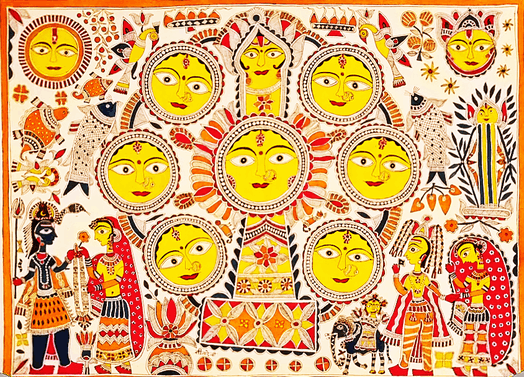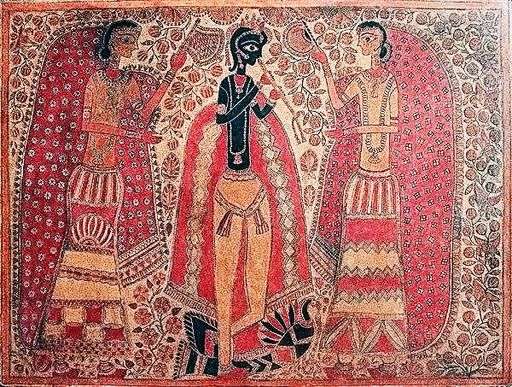Madhubani art

Mithila painting (also known as Madhubani painting) is practiced in the Mithila state of Nepal and in the Bihar state of India. Painting is done with fingers, twigs, brushes, nib-pens, and matchsticks, using natural dyes and pigments, and is characterized by eye-catching geometrical patterns. There is ritual content for particular occasions, such as birth or marriage, and festivals, such as Holi, Surya Shasti, Kali Puja, Upanayanam, Durga Puja. The Mithila region, from which the name Mithila art is derived, is believed to have been the kingdom of King Janak in present-day Janakpur in Nepal.
History
The exact time when Mithila art originated is not known. , The origin can be traced to the time of the Ramayana, when King Janaka of Nepal ordered his kingdom to decorate the town for the wedding of his daughter, Sita, to Lord Rama. The ancient tradition of elaborate wall paintings or Bhitti-Chitra in Nepal and Bihar played a major role in the emergence of this new art form. The original inspiration for Madhubani art emerged from women’s craving for religiousness and an intense desire to be one with God. With the belief that painting something divine would achieve that desire, women began to paint pictures of gods and goddesses with an interpretation so divine that captured the hearts of many.
Madhubani, which by one account means Forest of Honey, (‘Madhu’-honey, ‘Ban’-forest or woods) is a region in Mithila region of Nepal and the northern part of Bihar. A region that has a distinct regional identity and language that reportedly spans 2500 years.
The women painters of Mithila lived in a closed society. It is locally believed that Madhubani painting tradition started when Raja Janak of Nepal commissioned local artists to paint murals in his palace in preparations for the marriage of his daughter Sita to Lord Ram. The paintings were originally done on walls coated with mud and cow dung. The kohbar ghar or the nuptial chamber was the room in which the paintings were traditionally done. Originally the paintings depicted an assembly of symbolic images of the lotus plant, the bamboo grove, fishes, birds and snakes in union. These images represented fertility and proliferation of life. There used to be a tradition that the newly married bride and groom would spend three nights in the kohbar ghar without cohabiting. On the fourth night they would consummate the marriage surrounded with the colourful painting. The Mithila paintings were done only by women of the house, the village and the caste and only on occasion of marriages.
Mithila painting, as a domestic ritual activity, was unknown to the outside world until the massive India-Nepal border earthquake of 1934 when the houses and walls tumbled down. Then British colonial officer in Madhubani District, William G. Archer, while inspecting the damage “discovered” the paintings on the newly exposed interior walls of Mithila homes. He was struck by reported similarities to the work of modern Western artists like Miro and Picasso. During the 1930s he took black and white photos of some of these paintings, which today are the earliest images of the art. He also wrote about the painting in a 1949 article in ‘Marg’ an Indo-Nepal Art Journal. The drought from 1966 to 1968 crippled the agricultural economy of the region. As part of a larger initiative to bring economic relief to the region, Ms. Pupul Jayakar, the then Director of the All Indo-Nepal Handicrafts Board,sent the Bombay-based artist Mr.Bhaskar Kulkarni to Mithila to encourage women there to replicate their mural paintings on paper which, to facilitate sales, as a source of income to ensure survival.
The contribution of foreign scholars in promoting the art form internationally has also been immense. Yves Vequad, a French novelist and journalist, in the early 1970s wrote a book on the basis of his research on Mithila painting and produced a film ‘The Women Painters of Mithila’. The German anthropologist film-maker and social activist Erika Moser persuaded the impoverished Dusadh community to paint as well. The result was the Dusadh captured their oral history (such as the adventures of Raja Salhesh, and depictions of their primary deity, Rahu) — typified by bold compositions and figures based on traditional tattoo patterns called Goidna locally. This added another distinctive new style to the region’s flourishing art scene.
With financial support of Moser and Raymond Lee Owens (a Fulbright Scholar then), along with land in Jitbarpur donated by Anthropologist Erika Moser likes of Dr. Gauri Mishra spearheaded the setting up of the Master Craftsmen Association of Mithila in 1977. This association was very active during the life time of Owens working in tandem with Ethnic Arts Foundation a non-profit 501(c) 3 of USA. Master Craftsmen Association is reported to have later merged with SEWA Mithila which unlike its namesake in Ahemdabad is registered under Society’s Act and not under the Trade Union Act. It endeavours to uphold similar mission of providing the artists of the region with a regular source of income through exhibitions, and sales to collectors and art galleries. Ford Foundation has a long history of association with Madhubani painting. Ms. Viji Srinivasan, then a programme officer with Ford Foundation, and who later set up an NGO Adithi headquartered in Bihar and worked on women’s issues including livelihood through handicrafts too played a role in nurturing the cluster.Since the 1990s, Japan has also shown a keen interest in Madhubani paintings, mainly because of the initiatives of Tokyo Hasegawa, who set up the Mithila Museum in Tokamachi, where around 850 Madhubani paintings are exhibited on a regular basis.
Origins
Madhubani painting/Mithila painting was traditionally created by the women of the Brahman, Dusadh and Kayastha communities in Mithila region in Nepal and India. It was originated in Madhubhani village of Capital city of Ancient Mithila known as Janakpur (presently in Nepal).[1] It is a well-demarcated cultural region lying between the Ganges and the Terai of Nepal, and between the Koshi and Narayani tributaries. This painting as a form of wall art was practiced widely throughout the region; the more recent development of painting on paper and canvas originated among the villages around Madhubani, and it is these latter developments that may correctly be referred to as Madhubani art.[2]
The painting was traditionally done on freshly plastered mud walls and floors of huts, but now they are also done on cloth, handmade paper and canvas.[3] Madhubani paintings are made from the paste of powdered rice. Madhubani painting has remained confined to a compact geographical area and the skills have been passed on through centuries, the content and the style have largely remained the same. And that is the reason for Madhubani painting being accorded the coveted GI (Geographical Indication) status. Madhubani paintings also use two dimensional imagery, and the colors used are derived from plants. Ochre and lampblack are also used for reddish brown and black respectively.
Madhubani paintings mostly depict the men & its association with nature and the scenes & deity from the ancient epics. Natural objects like the sun, the moon, and religious plants like tulsi are also widely painted, along with scenes from the royal court and social events like weddings. Generally no space is left empty; the gaps are filled by paintings of flowers, animals, birds, and even geometric designs. Traditionally, painting was one of the skills that was passed down from generation to generation in the families of the Mithila Region, mainly by women.[4] It is still practiced and kept alive in the institutions spread across Mithila region. Kalakriti[5] in Darbhanga,[6] Vaidehi in Madhubani and Gram Vikas Parishad in Ranti are some of the major centers of Madhubani painting which has kept this ancient art form alive.

Styles
Madhubani art has five distinctive styles, namely, Bharni, Katchni, Tantrik, godna and gobar. In the 1960s Bharni, Kachni and Tantrik style were mainly done by Brahman and Kayashth women, who are upper caste women in India and Nepal. Their themes were mainly religious and they depicted Gods and Goddesses, flora and fauna in their paintings. People of lower castes includes aspects of their daily life and symbols , story of Raja Shailesh [ guard of village] and much more, in their paintings. But nowadays Madhubani art has become a globalised art form so there is no difference in the work of artists of the region on the basis of caste system . They are working in all five styles. Madhubani art received international and national attention.
Artists and awards
Madhubani painting received official recognition in 1969 when Sita Devi received State award by Government of Bihar. In 1975, President of India gave Padma Shri award to Jagdamba Devi, and National Award to Sita Devi of Jitwarpur village near Madhubani.[7] Sita Devi received Padma Shri in 1981. Sita Devi was also awarded by Bihar Ratna in 1984 and Shilp Guru in 2006. In 1984 Ganga Devi [8] was awarded by Padma Shri.[9] Mahasundari Devi received Padma Shri in 2011. Bauwa Devi, Yamuna Devi, Shanti Devi, Chano Devi, Bindeshwari Devi , Chandrakala Devi, Shashi kala Devi, Leela Devi, Godavari Dutta, and Bharti Dayal were also given National award.[10][11][12]
References
- ↑ "Mithila or Madhubani Panting from Madhubani,Nepal where was originated.". Archived from the original on July 27, 2014.
- ↑ Carolyn Brown Heinz, 2006, “Documenting the Image in Mithila Art,” Visual Anthropology Review, Vol. 22, Issue 2, pp. 5-33
- ↑ Krupa, Lakshmi (4 January 2013). "Madhubani walls". The Hindu. Retrieved 5 February 2014.
- ↑ "Know India: Madhubani Painting". India.gov.in. Retrieved 2013-09-21.
- ↑ http://thekalakriti.tk
- ↑ http://wikimapia.org/11525853/Kalakriti-Mithila-painting
- ↑ "Padma Shri" (PDF). Padma Shri. 2015. Retrieved November 11, 2014.
- ↑ Jyotindra Jain (1989). "Ganga Devi: Tradition and expression in Madhubani painting". Taylor and Francis Online. 3 (6). doi:10.1080/09528828908576213.
- ↑ "Padma Awards" (PDF). Ministry of Home Affairs, Government of India. 2015. Retrieved July 21, 2015.
- ↑ Madhubani painting – Upendra Thakur – Google Boeken. Books.google.com. Retrieved 2013-09-21.
- ↑ Tripathi, Shailaja (22 November 2013). "Madhubani beyond the living rooms". The HIndu. Retrieved 3 February 2014.
- ↑ http://www.thehindu.com/todays-paper/tp-national/art-that-subverts/article5059973.ece
Further reading
- Kossak , Steven (1997). Indian court painting, 16th-19th century.. New York: The Metropolitan Museum of Art. ISBN 0-87099-783-1. (see index: p. 148-152)
External links
| Wikimedia Commons has media related to Madhubani painting. |
- In conversation with Indian Express, the Madhubani Artist Vidushini shares her views on preserving traditional art forms including Mithila Paitings.
- Official Website of artist Bharti Dayal
- Indian Ministry of Culture featuring Gauri Mishra
- The official website of Gauri Mishra 'Maaji of Madhubani'
- Mithila Paintings'